PONTIAC G6 2006 Owners Manual
Manufacturer: PONTIAC, Model Year: 2006, Model line: G6, Model: PONTIAC G6 2006Pages: 416, PDF Size: 2.66 MB
Page 341 of 416
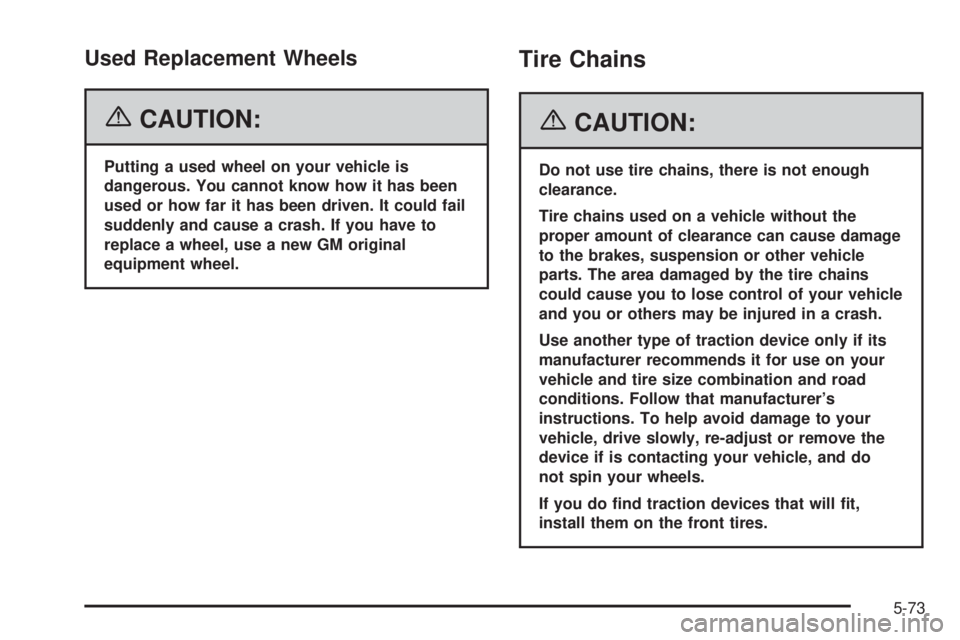
Used Replacement Wheels
{CAUTION:
Putting a used wheel on your vehicle is
dangerous. You cannot know how it has been
used or how far it has been driven. It could fail
suddenly and cause a crash. If you have to
replace a wheel, use a new GM original
equipment wheel.
Tire Chains
{CAUTION:
Do not use tire chains, there is not enough
clearance.
Tire chains used on a vehicle without the
proper amount of clearance can cause damage
to the brakes, suspension or other vehicle
parts. The area damaged by the tire chains
could cause you to lose control of your vehicle
and you or others may be injured in a crash.
Use another type of traction device only if its
manufacturer recommends it for use on your
vehicle and tire size combination and road
conditions. Follow that manufacturer’s
instructions. To help avoid damage to your
vehicle, drive slowly, re-adjust or remove the
device if is contacting your vehicle, and do
not spin your wheels.
If you do �nd traction devices that will �t,
install them on the front tires.
5-73
Page 342 of 416

If a Tire Goes Flat
It is unusual for a tire to blowout while you are driving,
especially if you maintain your vehicle’s tires properly.
If air goes out of a tire, it is much more likely to leak out
slowly. But if you should ever have a blowout, here
are a few tips about what to expect and what to do:
If a front tire fails, the �at tire will create a drag that pulls
the vehicle toward that side. Take your foot off the
accelerator pedal and grip the steering wheel �rmly.
Steer to maintain lane position, and then gently brake to
a stop well out of the traffic lane.
A rear blowout, particularly on a curve, acts much like a
skid and may require the same correction you would
use in a skid. In any rear blowout remove your foot from
the accelerator pedal. Get the vehicle under control
by steering the way you want the vehicle to go. It may
be very bumpy and noisy, but you can still steer.
Gently brake to a stop, well off the road if possible.{CAUTION:
Lifting a vehicle and getting under it to do
maintenance or repairs is dangerous without
the appropriate safety equipment and training.
The jack provided with your vehicle is
designed only for changing a �at tire. If it is
used for anything else, you or others could be
badly injured or killed if the vehicle slips off
the jack. Use the jack provided with your
vehicle only for changing a �at tire.
If a tire goes �at, the next part shows how to use the
jacking equipment to change a �at tire safely.
Changing a Flat Tire
If a tire goes �at, avoid further tire and wheel damage
by driving slowly to a level place. Turn on your
hazard warning �ashers.
5-74
Page 343 of 416
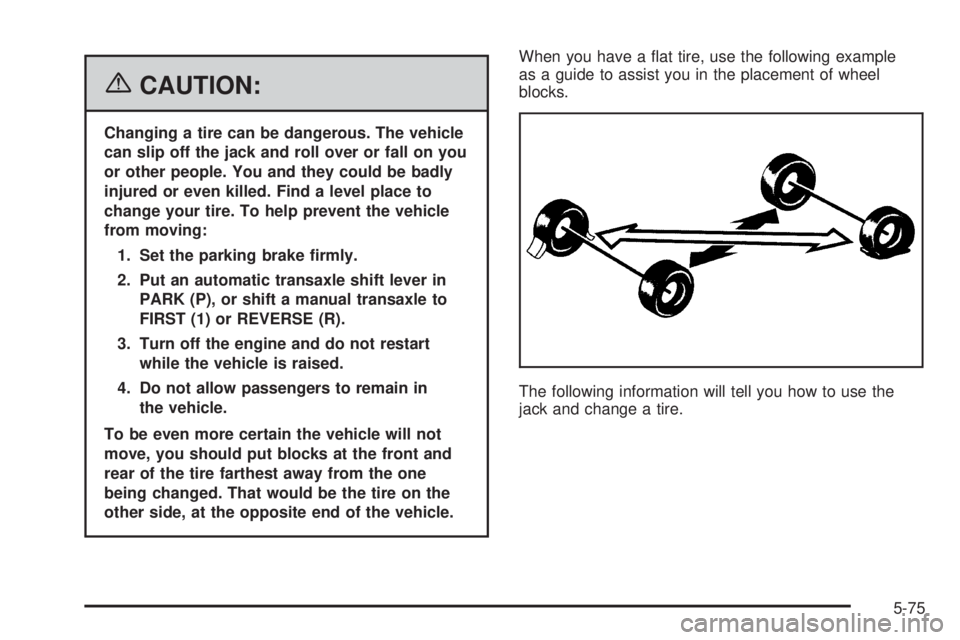
{CAUTION:
Changing a tire can be dangerous. The vehicle
can slip off the jack and roll over or fall on you
or other people. You and they could be badly
injured or even killed. Find a level place to
change your tire. To help prevent the vehicle
from moving:
1. Set the parking brake �rmly.
2. Put an automatic transaxle shift lever in
PARK (P), or shift a manual transaxle to
FIRST (1) or REVERSE (R).
3. Turn off the engine and do not restart
while the vehicle is raised.
4. Do not allow passengers to remain in
the vehicle.
To be even more certain the vehicle will not
move, you should put blocks at the front and
rear of the tire farthest away from the one
being changed. That would be the tire on the
other side, at the opposite end of the vehicle.When you have a �at tire, use the following example
as a guide to assist you in the placement of wheel
blocks.
The following information will tell you how to use the
jack and change a tire.
5-75
Page 344 of 416
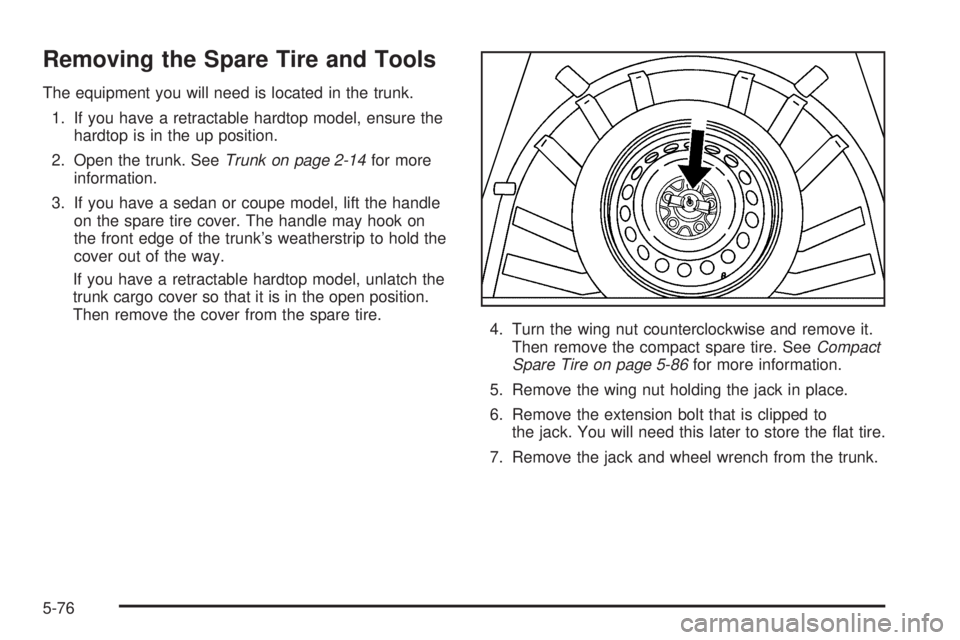
Removing the Spare Tire and Tools
The equipment you will need is located in the trunk.
1. If you have a retractable hardtop model, ensure the
hardtop is in the up position.
2. Open the trunk. SeeTrunk on page 2-14for more
information.
3. If you have a sedan or coupe model, lift the handle
on the spare tire cover. The handle may hook on
the front edge of the trunk’s weatherstrip to hold the
cover out of the way.
If you have a retractable hardtop model, unlatch the
trunk cargo cover so that it is in the open position.
Then remove the cover from the spare tire.
4. Turn the wing nut counterclockwise and remove it.
Then remove the compact spare tire. SeeCompact
Spare Tire on page 5-86for more information.
5. Remove the wing nut holding the jack in place.
6. Remove the extension bolt that is clipped to
the jack. You will need this later to store the �at tire.
7. Remove the jack and wheel wrench from the trunk.
5-76
Page 345 of 416

The tools you will be using include the wheel wrench (A)
and jack (B).1. Turn the plastic wing nut counterclockwise to
loosen the wheel wrench.
2. Unhook the wheel wrench from the jack.
5-77
Page 346 of 416
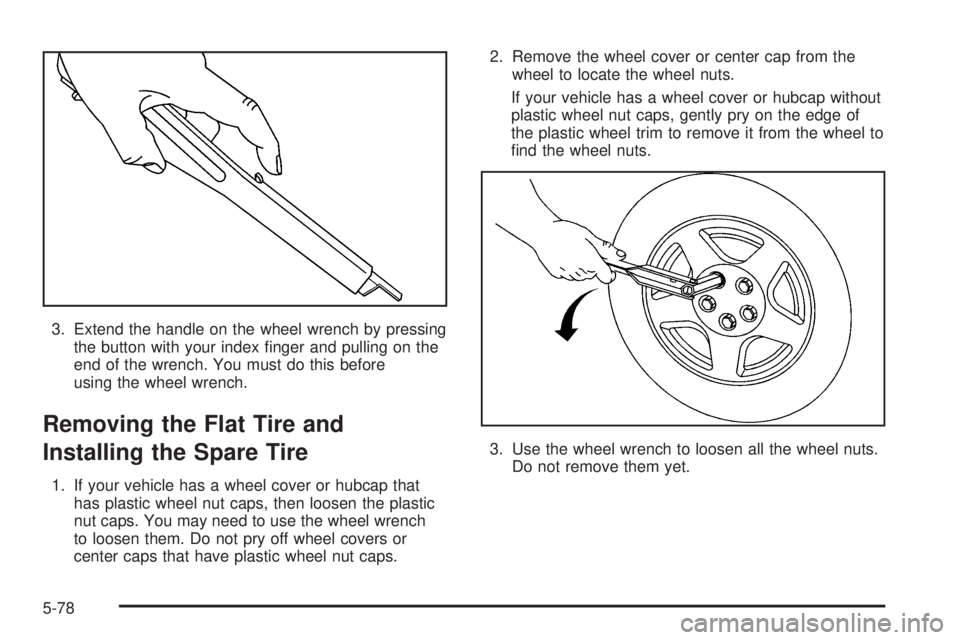
3. Extend the handle on the wheel wrench by pressing
the button with your index �nger and pulling on the
end of the wrench. You must do this before
using the wheel wrench.
Removing the Flat Tire and
Installing the Spare Tire
1. If your vehicle has a wheel cover or hubcap that
has plastic wheel nut caps, then loosen the plastic
nut caps. You may need to use the wheel wrench
to loosen them. Do not pry off wheel covers or
center caps that have plastic wheel nut caps.2. Remove the wheel cover or center cap from the
wheel to locate the wheel nuts.
If your vehicle has a wheel cover or hubcap without
plastic wheel nut caps, gently pry on the edge of
the plastic wheel trim to remove it from the wheel to
�nd the wheel nuts.
3. Use the wheel wrench to loosen all the wheel nuts.
Do not remove them yet.
5-78
Page 347 of 416

4. Position the lift head at the jack location nearest
the �at tire. Make sure all of the jack lift head is
touching the jacking �ange under the body. Do not
place the jack under a body panel. The lower
body panel has an arrow to aid in locating the
jacking location.
5. Put the compact spare tire near you.
{CAUTION:
Getting under a vehicle when it is jacked up
is dangerous. If the vehicle slips off the jack
you could be badly injured or killed. Never
get under a vehicle when it is supported only
by a jack.
5-79
Page 348 of 416

{CAUTION:
Raising your vehicle with the jack improperly
positioned can damage the vehicle and even
make the vehicle fall. To help avoid personal
injury and vehicle damage, be sure to �t the
jack lift head into the proper location before
raising the vehicle.6. Raise the vehicle by turning the wheel wrench
clockwise. Raise the vehicle far enough off the
ground so there is enough room for the compact
spare tire to �t underneath the wheel well.
7. Remove all of the wheel nuts.
8. Remove the �at tire.
{CAUTION:
Rust or dirt on the wheel, or on the parts to
which it is fastened, can make the wheel nuts
become loose after a time. The wheel could
come off and cause an accident. When you
change a wheel, remove any rust or dirt from
the places where the wheel attaches to the
vehicle. In an emergency, you can use a cloth
or a paper towel to do this; but be sure to use
a scraper or wire brush later, if needed, to get
all the rust or dirt off.
5-80
Page 349 of 416
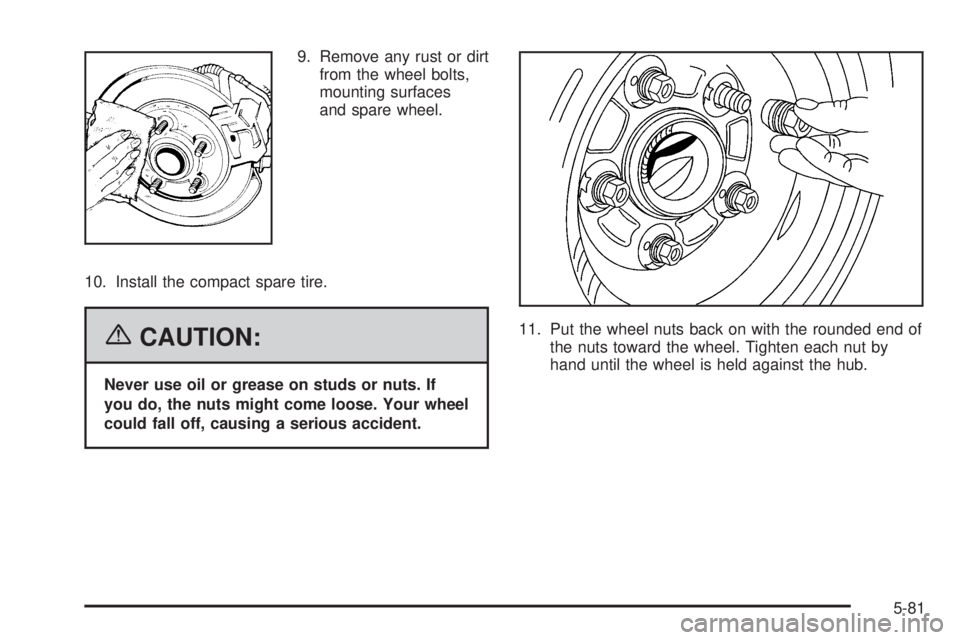
9. Remove any rust or dirt
from the wheel bolts,
mounting surfaces
and spare wheel.
10. Install the compact spare tire.
{CAUTION:
Never use oil or grease on studs or nuts. If
you do, the nuts might come loose. Your wheel
could fall off, causing a serious accident.11. Put the wheel nuts back on with the rounded end of
the nuts toward the wheel. Tighten each nut by
hand until the wheel is held against the hub.
5-81
Page 350 of 416

12. Lower the vehicle by turning the wheel wrench
counterclockwise. Lower the jack completely.
{CAUTION:
Incorrect wheel nuts or improperly tightened
wheel nuts can cause the wheel to come loose
and even come off. This could lead to an
accident. Be sure to use the correct wheel
nuts. If you have to replace them, be sure to
get new GM original equipment wheel nuts.
Stop somewhere as soon as you can and have
the nuts tightened with a torque wrench to the
proper torque speci�cation. SeeCapacities
and Specifications on page 5-105for wheel nut
torque speci�cation.
Notice:Improperly tightened wheel nuts can lead
to brake pulsation and rotor damage. To avoid
expensive brake repairs, evenly tighten the wheel
nuts in the proper sequence and to the proper
torque speci�cation. SeeCapacities and
Specifications on page 5-105for the wheel nut
torque speci�cation.
5-82